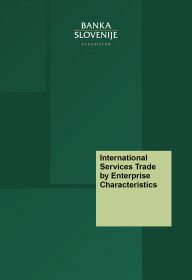
External Statistics
External statistics provide information on Slovenia's economic relations with the rest of the world. They serve as key indicators of the situation and trends in the economy, and are vital component of the national accounts system.
The balance of payments discloses transactions, and consists of three main accounts: the current account, the capital account, and the financial account. The primary criterion for capturing a transaction is a change of ownership.
The international investment position reflects the total stock of financial assets and liabilities held by the domestic economy vis-à-vis the rest of the world. The net international investment position is defined as the difference between these assets and liabilities.
The external debt position represents the value of debt instruments (excluding equity instruments and financial derivatives) owed to or lent to the rest of the world by the domestic economy. Net external debt is defined as the difference between non-residents’ holdings of these liabilities and assets.
Direct investment statistics by direction of investment show the stock of inward investments from the rest of the world and outward investments by the domestic economy, where the investor has a lasting interest and significant influence over the governance of a foreign enterprise.
The methodological framework for external statistics is based on the sixth edition of the Balance of Payments Manual (BPM6) published by the IMF (International Monetary Fund). It also incorporates specialised manuals related to external debt, direct investment, services statistics and international monetary reserves, all of which are aligned with the BPM6.
Highlighted
Upcoming
7. November | International reserves October 2025 | 13. November | Balance of payments Gross external debt Travels (Slovene only) September 2025 |
International reserves and foreign currency liquidity October 2025 | |||
Data
Tables
International Investment Position
Data series
Balance of Payments | International Investment Position and External Debt | Direct Investments | International Reserves |
|---|---|---|---|
Financial indicators of foreign companies ultimately controlled by Slovenian companies | |||
Links to other data sources
Publications

International services trade by enterprise characteristics in 2024
Methodological notes
Featured
Foreign firms controlled by Slovenian investors 2024
We are publishing the initial release of the 2024 performance indicators for foreign firms controlled by Slovenian ultimate investors, and revised figures for 2023. The majority of the data is taken from direct reporting by Slovenian investors about the performance of their controlled firms in the rest of the world.
The data series entitled Performance indicators of foreign firms controlled by Slovenian ultimate investors is also available on the Banka Slovenije website under data series section (Link).
Short analysis and methodological explanations are available at the links below.
Slovenian firms controlled 2,205 firms in the rest of the world in 2024, down 0.4% on the previous year. They generated EUR 16,419 million of sales revenue and employed 66,210 people in 2024, up 4.6% and 0.4% respectively on the previous year. Of the controlled firms in the rest of the world, 84% were under Slovenian ultimate ownership, while 16% were ultimately controlled by foreign investors via Slovenian firms.
Table 1: Performance indicators according to residency of ultimate investor
Source: Banka Slovenije
The 1,854 foreign firms under Slovenian ultimate ownership generated sales revenue of EUR 11,799 million in 2024, and employed 45,171 people. Their labour costs amounted to EUR 1,032 million. The sales revenue figure was up 6% on the previous year, while labour costs were up 9%. The largest factor in these developments was manufacturing, which accounted for 77% of the total increase in revenues and 62% of the growth in labour costs. The total headcount at controlled firms in the rest of the world remained at a similar level to the previous year.
In terms of investment activity, the most important countries for Slovenian ultimate investor firms are the former Yugoslav republics, most notably Croatia and Serbia. Subsidiaries in these countries generated sales revenue of EUR 8,315 million in 2024, or 70% of the total sales revenue of controlled firms in the rest of the world. This region is even more important from the perspective of headcount, with the 35,366 employees at firms there accounting for 78% of the total headcount at controlled firms in the rest of the world, and from the perspective of capital expenditure, with their figure of EUR 270 million accounting for 82% of the total. Labour costs per employee at the subsidiaries in this region averaged EUR 20,150 in 2024, significantly less than at the parent undertakings in Slovenia, where the figure stood at EUR 46,202. Alongside geographical proximity and good knowledge of the local economic environment, the lower labour costs are one of the key factors driving the decisions by Slovenian firms to invest in subsidiaries in the former Yugoslav republics. Alongside the aforementioned region, firms in other countries also play an important role for Slovenian investors, most notably Russia, where subsidiaries generated sales revenue of EUR 659 million in 2024 and employed 1,911 people. Other important countries were Germany (EUR 311 million of revenue and 701 employees), Austria (EUR 277 million of revenue and 226 employees), Poland (EUR 157 million of revenue and 999 employees) and Turkey (EUR 100 million and 1,163 employees).
Figure 1: Selected indicators for the four most important recipients of outward FDI in 2024
Source: Banka Slovenije
The largest number of foreign firms controlled by Slovenian investors in 2024 were in wholesale and retail trade and repair of motor vehicles and motorcycles. These firms generated sales revenue of EUR 4,511 million (38% of the total), and had 11,182 employees (25% of the total). The largest headcount at controlled firms in the rest of the world was recorded in manufacturing, in the amount of 16,795 employees (37% of the total), where the firms generated sales revenue of EUR 2,780 million (24% of the total). This activity also recorded the largest capital expenditure, in the amount of EUR 94 million (29% of the total). Financial and insur-ance activities is also an activity of importance to Slovenian investors, with EUR 1,777 million of sales revenue and 8,892 employees.
Figure 2: Indicators for most important activities in 2024
Source: Banka Slovenije
This publication illustrates the performance indicators of foreign firms controlled by Slovenian firms. The indicators are based on the 2012 Foreign Affiliates Statistics (FATS) Recommendations Manual.
The data source for the indicators is the SN11 annual report, within the framework of which indicators are reported for firms in the rest of the world in which the reporter holds (direct/indirect) control, i.e. where the reporter's interest exceeds 50%. The data relates to the overall performance of the firms in the rest of the world, and not solely to the holding pertaining to the reporter.
As of the 2023 reporting year, the obligation to submit an SN11 report has applied to all resident legal persons whose total assets exceeded EUR 5 million on any day in the reporting period and who on any day in the reporting period:
– held at least 10% of the equity or shares of a legal person in the rest of the world,
– held a holding in investment funds established in the rest of the world,
– were a founder of a branch in the rest of the world that pursues profit-making activities, or
– owned real estate in the rest of the world.
(Legal basis: Official Gazette of the Republic of Slovenia, No. 157/22)
Different thresholds for the reporting obligation applied in previous reporting periods: the total assets threshold was set at EUR 2 million between 2017 and 2022, and there was no lower threshold before 2017.
Estimates of the relevant indicators for Croatian firms owned by Slovenian natural persons were drawn up for the reporting year of 2022 and subsequent years on the basis of bilateral data exchange with Croatia.
The report on indicators includes the following data:
the country of the controlled foreign firms,
the activities of the controlled foreign firms,
the number of controlled foreign firms,
the number of employees (the average headcount at controlled firms in the rest of the world in the reporting year based on hours worked),
employee costs (labour costs incurred by controlled firms in the rest of the world),
sales revenue, where the content depends on the activity as illustrated in the table:
Table 2: Sales revenue according to activity
Source: Banka Slovenije
exports of goods and services (total exports of goods and services of controlled firms in the rest of the world), including itemisation of exports of goods and services to firms in the group;
imports of goods and services (total imports of goods and services of controlled firms in the rest of the world), including itemisation of imports of goods and services from firms in the group;
capital expenditure, including:
– purchases of (physically generated) own non-current assets,
– upgrades, reconstruction and renovation of existing non-current assets,
– own construction of non-current assets and acquisition thereof without payment,
– historical cost of non-current assets in finance leasing,
– investment property, if it is evident that it will bring economic rewards in the form of rents or an increase in value, and if its historical cost is available.


